Matcha
Why Your Matcha Tastes Like Dirt & Fixes

Are you a matcha enthusiast seeking mastery over its complex flavors?
We understand that you might have heard some whispers about matcha tasting like dirt. However, let us assure you that there’s much more to this vibrant green tea powder than meets the eye.
In this exploration, we will delve into the origins of matcha, unravel its unique flavor profile, and uncover the factors contributing to its earthy taste.
While it’s true that matcha can have a hint of earthiness, we’re here to guide you on how to embrace and appreciate this characteristic.

So, join us on this journey as we unlock the secrets behind matcha’s distinctive flavor and discover ways to enjoy it without the dirt-like taste.
Key Takeaways
- Matcha has an earthy taste that is either loved or hated and is considered an acquired taste by some individuals.
- The earthiness contributes to matcha’s health benefits, such as its high antioxidant content.
- Matcha’s earthy taste comes from its high chlorophyll content and unique production process.
- Experimenting with ingredients and brewing methods can enhance matcha’s natural flavor and balance out the earthiness.
The Origins of Matcha
The origins of matcha can be traced back to ancient Japan and its rich tea-drinking culture. Matcha, a powdered green tea, has a long history steeped in tradition and historical significance.
One of the key factors contributing to the unique flavor and quality of matcha is the soil composition in which it’s grown. The lush, volcanic soil of Japan provides the perfect conditions for cultivating tea plants that produce vibrant, flavorful leaves. This soil composition not only enhances the taste of matcha but also contributes to its nutritional value and overall quality.
The historical significance of matcha can’t be overstated, as it has been an integral part of Japanese tea ceremonies for centuries, symbolizing harmony, respect, and tranquility. The rich cultural heritage associated with matcha adds to its allure and continues to captivate tea enthusiasts worldwide.

Understanding Matcha’s Flavor Profile
To truly understand matcha’s flavor profile, we must delve into its unique combination of grassy, vegetal notes, and subtle sweetness. Matcha isn’t your average green tea; it has a distinct taste that sets it apart. When prepared properly, matcha offers a rich umami flavor that’s both refreshing and satisfying.
The health benefits of matcha are well-known, but its flavor secrets are equally intriguing. The grassy undertones give matcha a fresh and vibrant taste, while the vegetal notes add depth and complexity. The subtle sweetness rounds out the flavor, leaving a pleasant aftertaste that lingers on the palate. Understanding these nuances is essential for anyone seeking mastery in the world of matcha.
Now, let’s explore the earthy taste of matcha and how it contributes to its unique flavor profile.
The Earthy Taste of Matcha
When it comes to matcha, the earthy taste is either loved or hated. Some may find it an acquired taste, while others may perceive it as a bold flavor that adds depth to their cup.
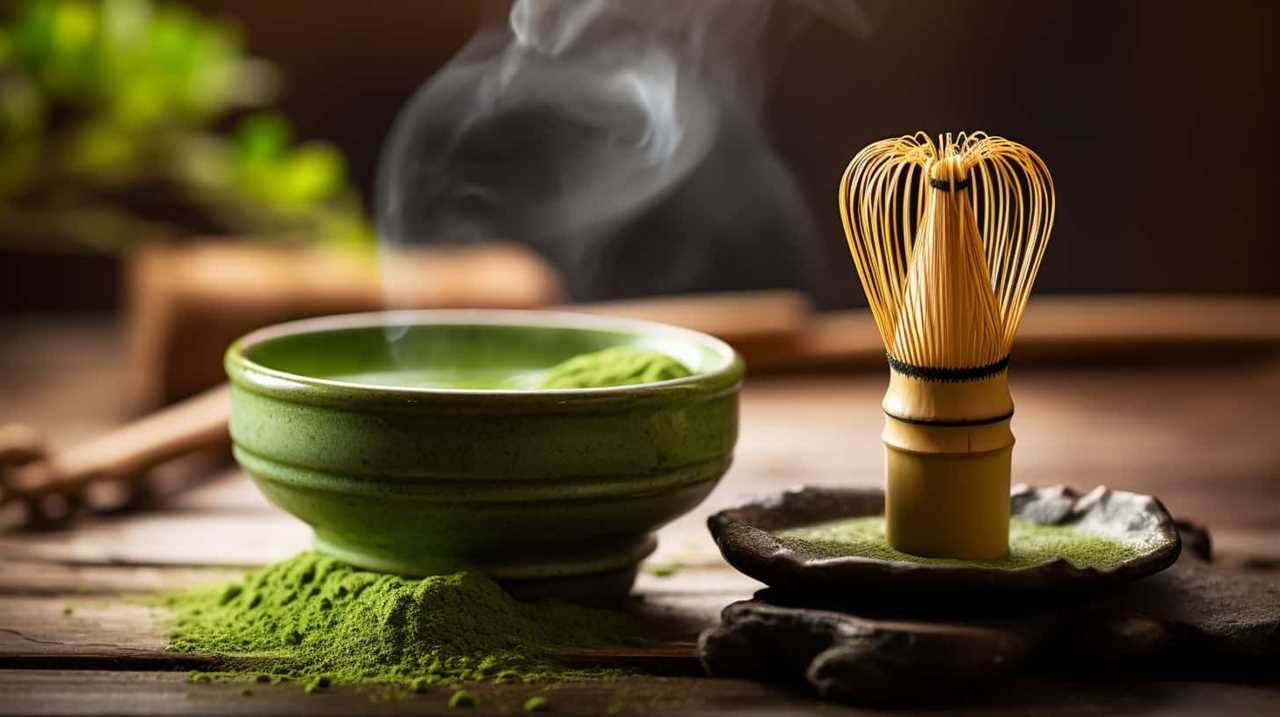
Regardless of personal preference, it’s important to acknowledge the health benefits that come with this earthiness, such as its high antioxidant content.
To enhance the natural flavor of matcha, experimenting with different brewing methods and pairing it with complementary ingredients can take your matcha experience to a whole new level.
Acquired Taste or Not
We found that matcha has an earthy taste that some may consider an acquired flavor. This acquired taste controversy stems from the variation in taste perception among individuals. Here are some key points to consider when it comes to the earthy taste of matcha:
- Complexity: Matcha’s earthy flavor is a result of its unique production process, where shade-grown tea leaves are ground to a fine powder. This process creates a rich, vegetal taste that can be described as earthy or grassy.
- Nutritional benefits: Matcha is known for its high concentration of antioxidants and nutrients, which contribute to its distinct flavor profile.
- Cultural significance: Matcha has a long history in Japanese tea ceremonies and has become a popular ingredient in various culinary creations, showcasing its versatility despite its acquired taste.
- Personal preference: Taste preferences vary from person to person, and while some may find matcha’s earthy taste off-putting, others appreciate its unique flavor and enjoy the experience of acquiring this taste.
Health Benefits of Earthiness
The health benefits of matcha’s earthy taste include its high concentration of antioxidants and nutrients. Stone ground matcha, in particular, retains more of these beneficial compounds compared to other processing methods.
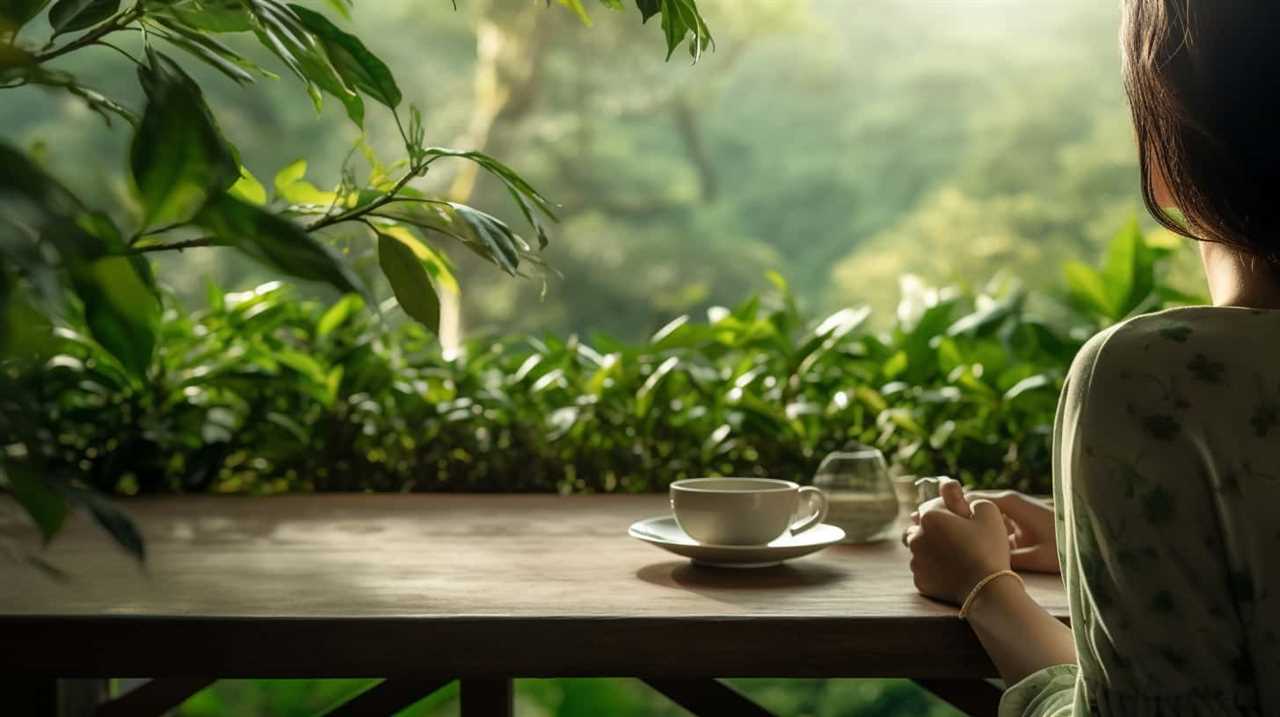
The earthiness of matcha comes from the leaves being grown in shaded conditions, which increases the chlorophyll content. This results in a unique taste that some may describe as ‘earthy’ or ‘grassy.’ While the flavor may not be everyone’s cup of tea, pardon the pun, the health benefits are undeniable.
Matcha is packed with catechins, a type of antioxidant that helps protect against cell damage, reduce inflammation, and support cardiovascular health. Additionally, matcha provides a good source of vitamins and minerals, including vitamins A, C, and E, as well as potassium and calcium.
Enhancing Matcha’s Natural Flavor
To enhance the natural flavor of matcha, we can explore various methods and ingredients that complement its earthy taste. Matcha flavor experiments are a fun and exciting way to discover new nuances and create a personalized matcha experience. Here are some matcha taste preferences and techniques that can help enhance its flavor:
- Adding a touch of sweetness: A small amount of honey or maple syrup can balance out the earthiness and add a hint of sweetness to your matcha.
- Mixing with other flavors: Experiment with different ingredients like vanilla extract, cinnamon, or even citrus zest to create unique flavor combinations that complement matcha’s earthy notes.
- Trying different milk options: Swap out regular dairy milk with alternatives like almond milk or coconut milk to add a creamy texture and enhance the overall taste.
- Adjusting water temperature: The temperature at which you whisk your matcha can greatly impact its flavor. Try experimenting with different water temperatures to find the perfect balance.
By exploring these methods and ingredients, you can tailor matcha to your taste preferences and elevate its natural earthy flavor.

Now, let’s delve into the factors contributing to matcha’s dirt-like flavor.
Factors Contributing to Matcha’s Dirt-like Flavor
One of the main factors behind matcha’s dirt-like flavor lies in the way it’s cultivated and processed using soil-rich methods. While these traditional techniques may contribute to the health benefits of matcha, they also play a significant role in its distinct taste.
Matcha leaves are grown in shaded areas, which increases the chlorophyll content and gives the tea its vibrant green color. However, this process also results in a stronger, earthy flavor that some may find reminiscent of dirt.
Furthermore, matcha leaves are ground into a fine powder, which allows for maximum consumption of the tea’s nutrients but also intensifies its taste.
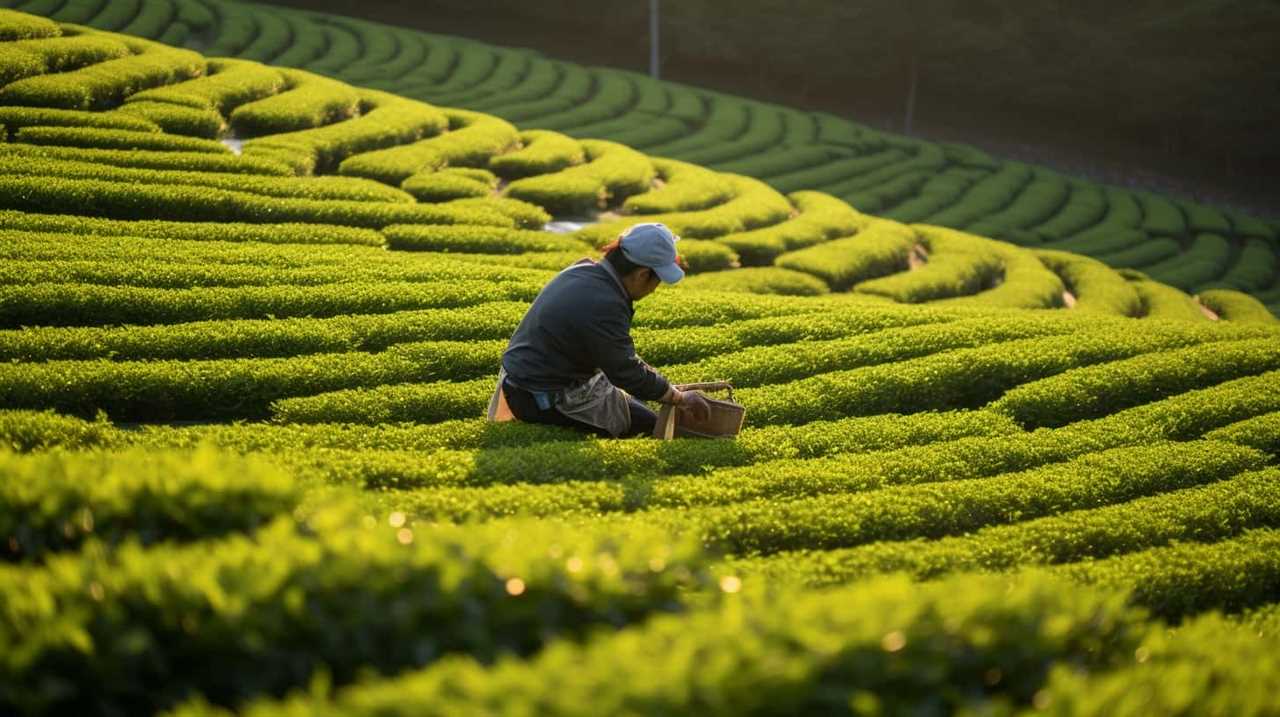
The Role of Soil in Matcha Production
Soil composition plays a crucial role in matcha production. The quality of the soil directly affects the flavor, aroma, and overall quality of the matcha tea.
Here are four key aspects of soil composition that have a significant impact on matcha production:
- Nutrient content: The soil needs to be rich in nutrients such as nitrogen, phosphorus, and potassium to support the growth of healthy tea plants.
- pH level: Matcha thrives in slightly acidic soil with a pH range of 5.5 to 6.5. This acidity helps to enhance the flavor and aroma of the tea leaves.
- Organic matter: Soil with a high organic matter content promotes the development of a complex flavor profile in matcha, resulting in a more enjoyable drinking experience.
- Environmental impact: Sustainable farming practices, such as organic cultivation and soil conservation techniques, not only protect the environment but also contribute to the production of high-quality matcha.
Understanding the importance of soil composition is essential for mastering the art of matcha production and ensuring the finest quality tea leaves.
Processing Methods and Matcha’s Taste
When it comes to matcha, the processing methods used can greatly impact its taste. Traditional techniques, such as stone grinding, result in a smoother and more flavorful matcha compared to modern methods.

The use of shade-grown leaves also plays a crucial role in enhancing the flavor profile of matcha, giving it a unique and distinct taste.
Traditional Vs. Modern Techniques
To understand the difference in taste between traditional and modern matcha, it’s important to consider the various processing methods used. The techniques employed in producing matcha have evolved over time, leading to distinct flavor profiles. Here are some key points to consider:
- Traditional vs. Modern Techniques:
- Traditional methods involve shading the tea leaves before harvest, resulting in a rich umami flavor.
- Modern techniques prioritize efficiency and mass production, often leading to a more astringent taste.
- Impact of Stone Grinding:
- Traditional matcha is stone-ground, which preserves the tea’s natural flavors and ensures a smooth texture.
- Modern matcha is often machine-ground, which can result in a grainy texture and slightly bitter taste.
Understanding these differences will enable enthusiasts to make informed choices and appreciate the nuances of matcha. Mastery of the traditional techniques can lead to a more authentic and enjoyable tea experience.
Impact of Stone Grinding
Stone grinding plays a significant role in determining the taste of matcha, enhancing its natural flavors and ensuring a smooth texture. Stone grinding techniques, when executed with precision and expertise, can extract the maximum flavor from the tea leaves, resulting in a vibrant and nuanced taste profile.
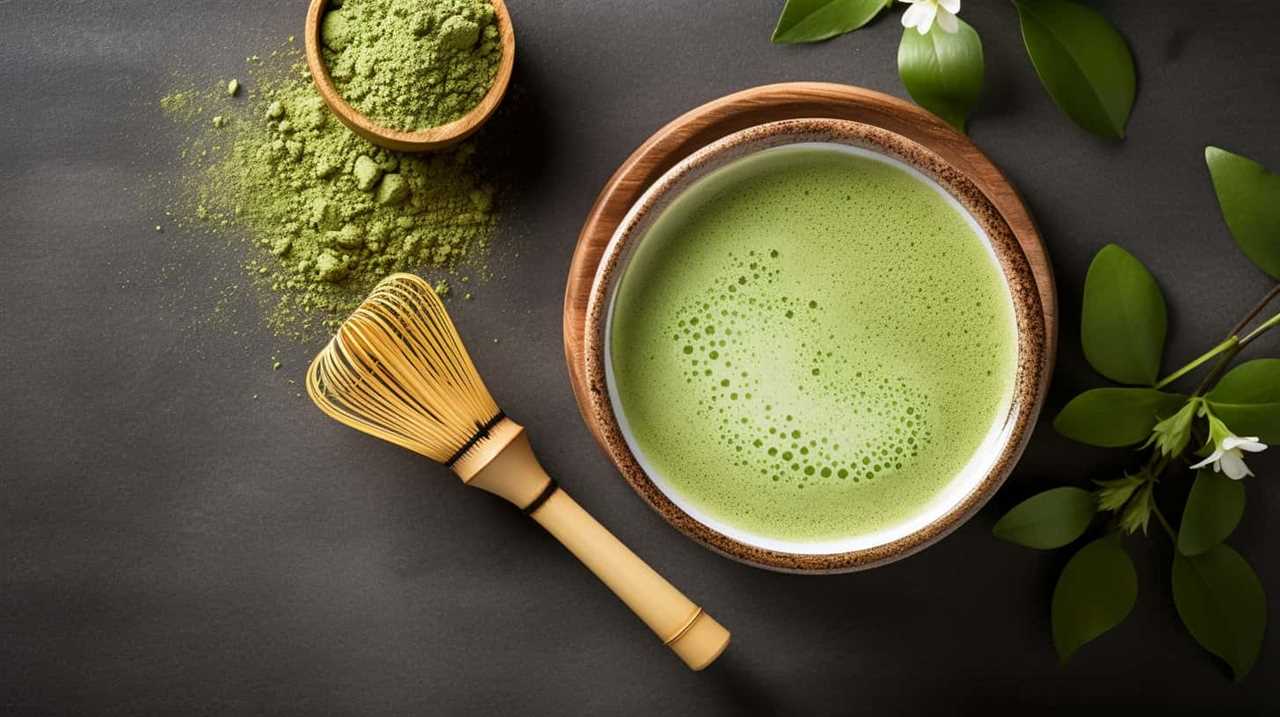
The traditional method of stone grinding involves using granite stone mills to finely grind the tea leaves, preserving their delicate flavors and aromas. This slow and meticulous process allows for the gradual release of the tea’s essence, resulting in a more complex and satisfying cup of matcha.
The friction generated during stone grinding also contributes to the creation of a smooth and velvety texture, further enhancing the overall drinking experience.
When it comes to matcha, the importance of stone grinding can’t be overstated as it’s the key to unlocking its true potential of flavor extraction.
Shade-Grown Leaves and Flavor
Continuing the discussion from the impact of stone grinding, we find that shade-grown leaves significantly contribute to the flavor of matcha.
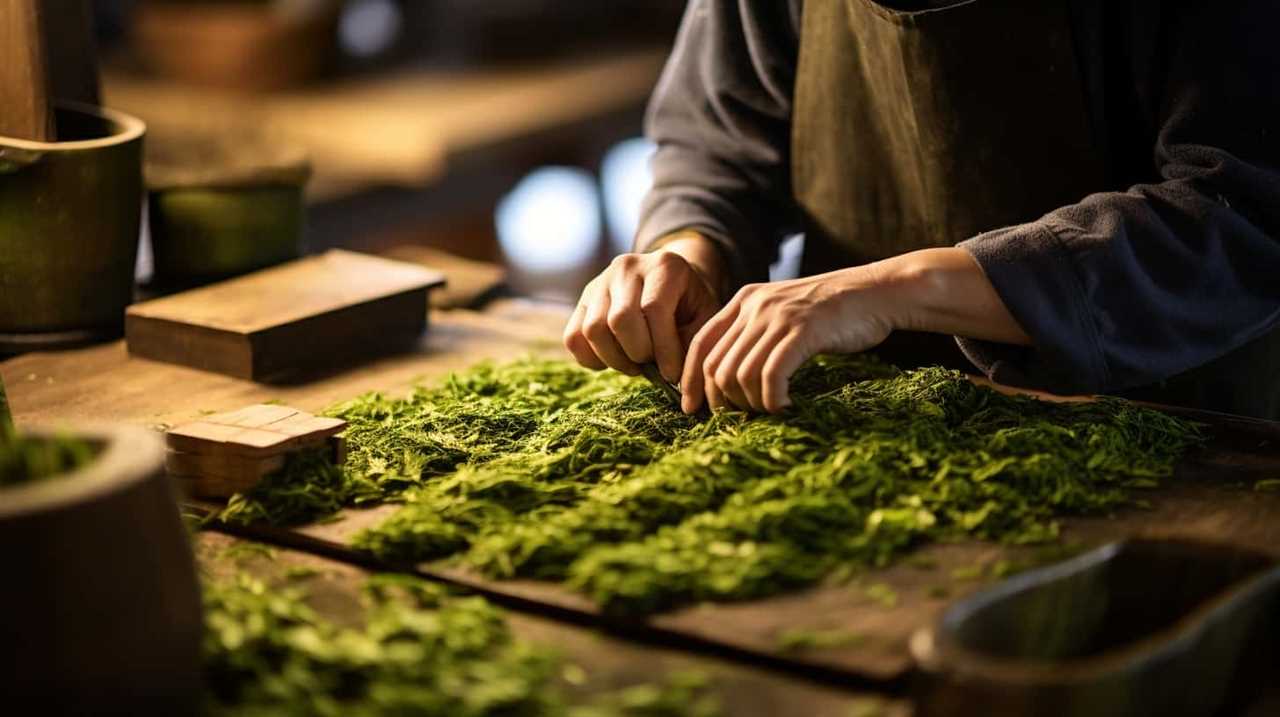
Matcha cultivation techniques play a crucial role in achieving the desired taste profile. Shade grown tea varieties, such as Tencha and Gyokuro, are carefully cultivated under shade for several weeks before harvest. This shading process enhances the production of chlorophyll, giving matcha its vibrant green color and distinct flavor.
The leaves produce higher levels of amino acids, particularly L-theanine, which contributes to matcha’s umami taste. Additionally, the shade reduces the bitterness of the leaves, resulting in a smoother and more balanced flavor.
The importance of shade in matcha cultivation can’t be overstated, as it directly impacts the final taste experience.
Now, let’s delve into the specifics of how shade is crucial in matcha cultivation.
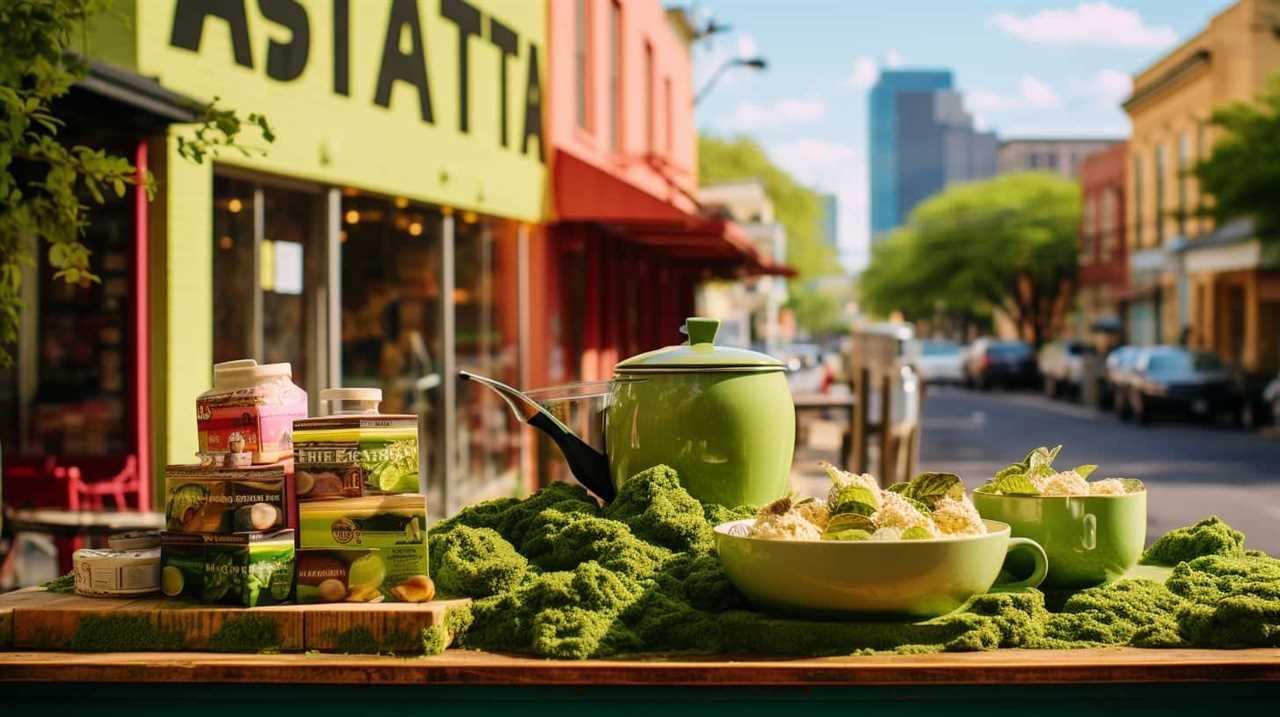
The Importance of Shade in Matcha Cultivation
In our matcha cultivation process, we understand the crucial role that shade plays. Shade isn’t just an optional element, but an absolute necessity for producing high-quality matcha.
The role of shade in matcha cultivation is paramount because it directly impacts the flavor development of the tea leaves. When matcha leaves are shielded from direct sunlight, they undergo a transformation that sets them apart from other green teas.
The shade encourages the tea leaves to produce more chlorophyll, resulting in a vibrant green color and a rich, umami flavor. The absence of sunlight also slows down the tea leaves’ growth, allowing them to accumulate more nutrients and develop a smoother, sweeter taste.
Without proper shade, matcha would lose its distinctive characteristics and become just another mediocre tea.
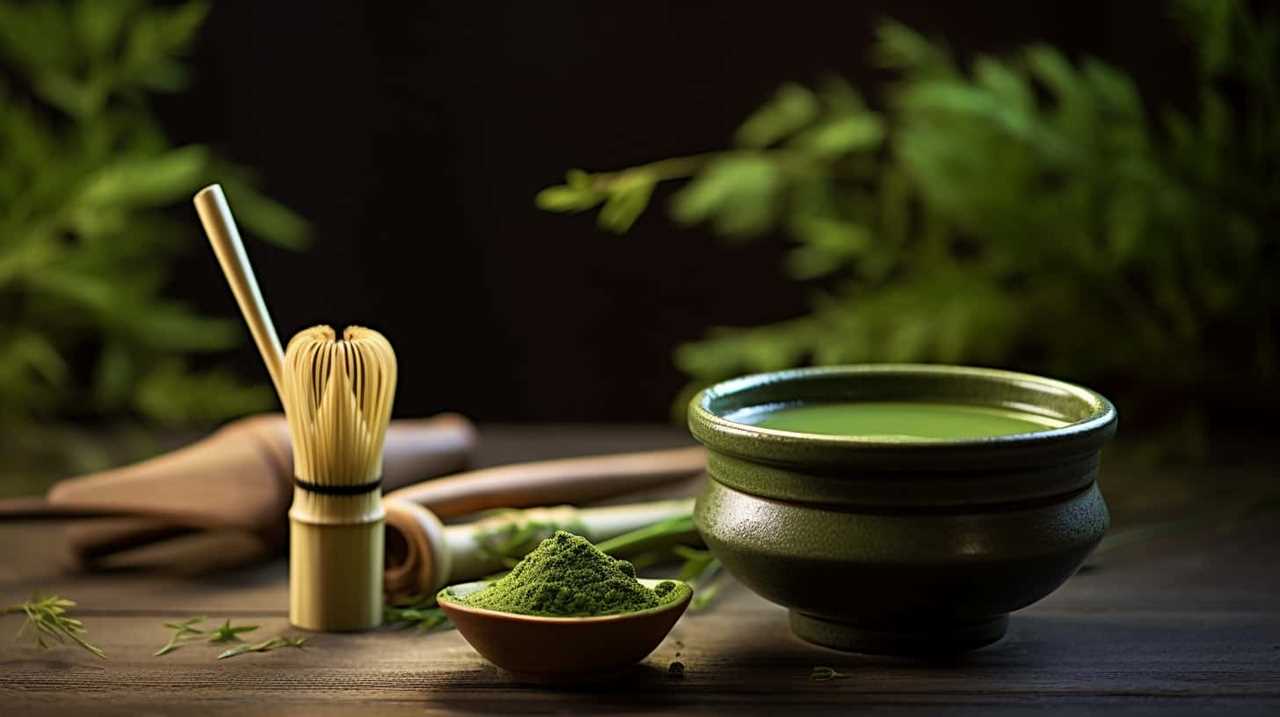
Matcha’s Unique Umami Flavor
When it comes to matcha, its unique umami flavor is what sets it apart from other types of tea. The umami taste can be described as earthy or savory, adding depth and complexity to the overall flavor profile.
It’s this distinct flavor that makes matcha a delight to drink and a favorite among tea enthusiasts.
Umami: Earthy or Savory
As we delve into the unique umami flavor of matcha, we discover its earthy and savory notes that set it apart from other teas. Matcha’s umami flavor is like a hidden treasure waiting to be unlocked. Here are some reasons why matcha’s flavor is truly one-of-a-kind:
- Earthiness in cooking: Matcha’s earthy undertones make it a versatile ingredient in cooking. It adds depth and richness to dishes like soups, sauces, and even desserts.
- Umami in other cuisines: Umami, often described as a savory taste, is highly prized in many cuisines around the world. Matcha’s umami flavor provides a unique twist to traditional dishes, adding complexity and enhancing the overall taste experience.
- A symphony of flavors: Matcha’s umami flavor is a harmonious blend of earthiness, sweetness, and a slight bitterness. It creates a well-balanced taste profile that’s both satisfying and intriguing.
- A sensory journey: Drinking matcha isn’t just about taste, but also about the sensory experience. The earthy and savory notes transport you to a serene and peaceful place, allowing you to fully immerse yourself in the moment.
As we explore the secrets of matcha’s flavor, we’ll uncover the various elements that contribute to its unique and captivating taste profile.
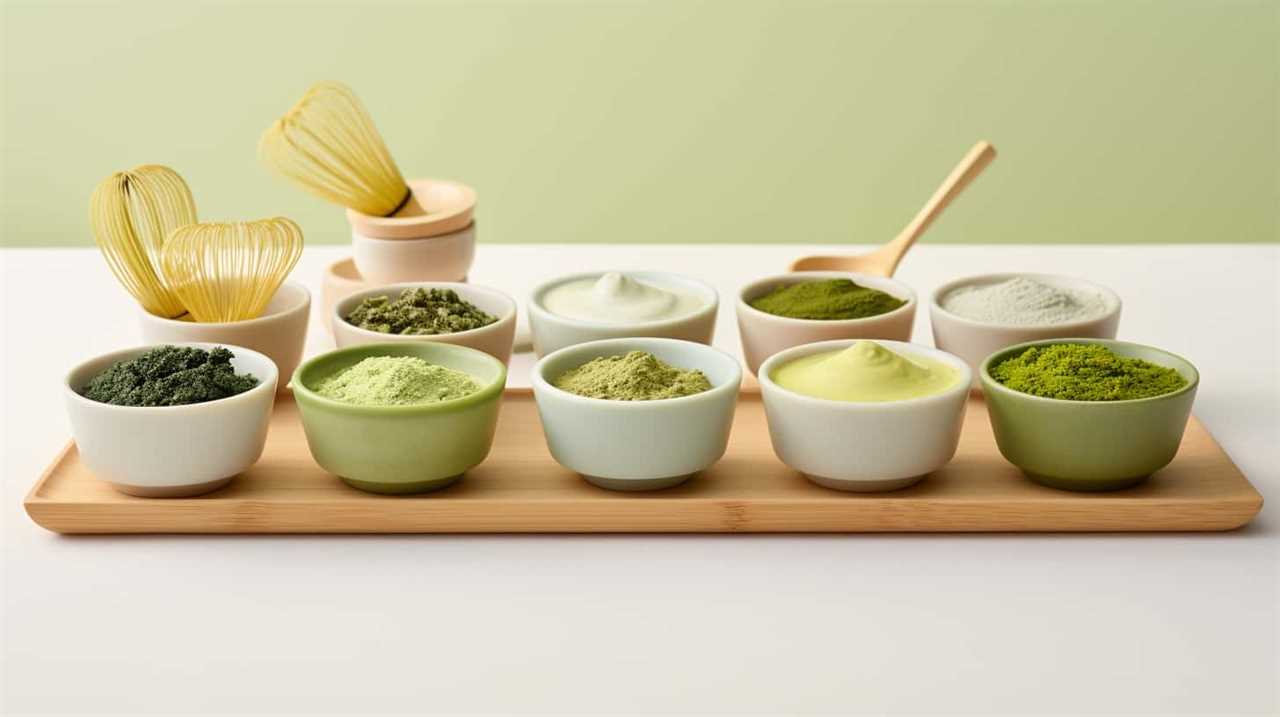
Matcha Flavor Secrets
Continuing our exploration of matcha’s flavor secrets, let’s delve into the unique umami flavor that sets matcha apart from other teas. Umami, often described as a savory or earthy taste, is a key characteristic of matcha that adds depth and complexity to its flavor profile. To truly understand the essence of matcha’s umami, let’s explore how it enhances matcha’s flavor and how it intertwines with the aroma.
| Enhancing Matcha’s Flavor | Exploring Matcha’s Aroma |
|---|---|
| High-quality matcha leaves harvested at the right time | Fragrant notes of fresh grass and seaweed |
| Careful shade-growing process | Subtle hints of vegetal sweetness |
| Hand-picked and stone-ground matcha powder | Delicate floral undertones |
| Proper whisking technique | Aromas that evoke a sense of tranquility and mindfulness |
| Sipping slowly to savor the rich, creamy texture | Layers of complexity that engage the senses |
Mastering matcha’s unique umami flavor requires attention to detail and a discerning palate. By enhancing its flavor and exploring its aromatic qualities, we unlock the full potential of this extraordinary tea.
Exploring Matcha’s Taste
To truly appreciate the unique umami flavor of matcha, we must delve into the depths of its taste profile. Matcha is an acquired taste that requires patience and an open mind. It isn’t a flavor that can be easily described, but rather one that must be experienced firsthand.
Here are some aspects of matcha’s taste that contribute to its distinctiveness:

- Rich and earthy: Matcha has a deep, vegetal flavor reminiscent of freshly cut grass and seaweed. This earthiness adds a layer of complexity to its taste.
- Creamy and smooth: Matcha has a velvety texture that coats the palate, leaving a lingering sensation of richness and indulgence.
- Bittersweetness: Matcha possesses a delicate balance of bitterness and sweetness. This unique combination stimulates the taste buds and creates a harmonious flavor profile.
- Umami explosion: Matcha is renowned for its umami flavor, which is often described as savory and brothy. This umami sensation adds depth and dimension to the overall taste experience.
In addition to its intriguing taste, matcha also offers numerous health benefits. From its high concentration of antioxidants to its ability to boost metabolism and enhance focus, matcha is truly a powerhouse of wellness.
Matcha Vs. Regular Green Tea: Taste Differences
While matcha and regular green tea may both be derived from the same plant, their taste differs significantly. Matcha, with its vibrant green color and smooth, creamy texture, offers a unique and distinct flavor profile that sets it apart from regular green tea. To better understand the taste differences, let’s compare the two in a table:
| Taste Preferences | Matcha | Regular Green Tea |
|---|---|---|
| Bitterness | Medium | Mild |
| Umami | Strong | Subtle |
| Vegetal Notes | Intense | Delicate |
Matcha, known for its slightly bitter taste, has a pleasant umami flavor that adds depth and richness. Its vegetal notes are intense, reminiscent of freshly cut grass or steamed vegetables. On the other hand, regular green tea has a milder bitterness and subtle umami taste. Its vegetal notes are delicate and refreshing. Acquiring a preference for matcha or regular green tea ultimately depends on individual taste preferences. Some may enjoy matcha’s bold and robust flavor, while others may prefer the lighter and more delicate taste of regular green tea. Experimenting with both can help you discover your personal preference and elevate your tea-drinking experience.
The Influence of Matcha Grade on Taste
Now let’s delve into how the grade of matcha can significantly impact its taste. Matcha grade refers to the quality of the matcha powder, which is determined by various factors such as the cultivation method, harvesting process, and the age of the leaves used. The grade of matcha can greatly influence its taste, making it crucial for matcha enthusiasts to understand the differences.
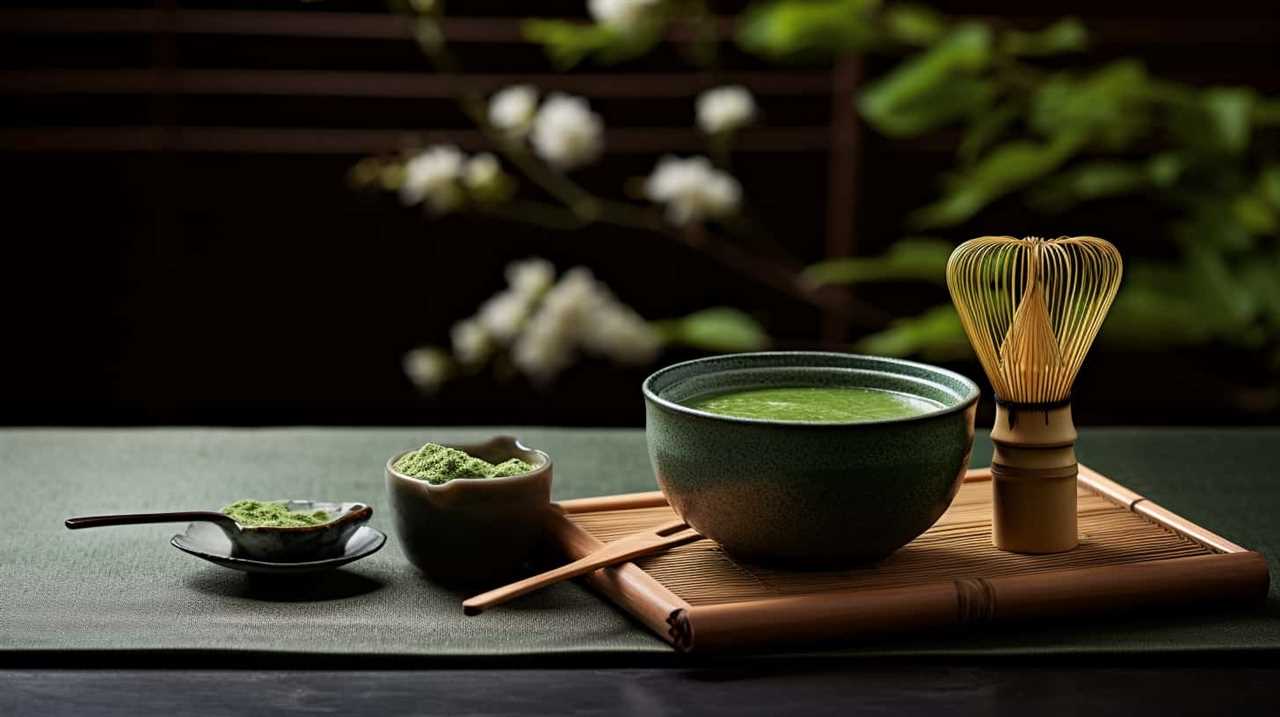
Here are a few key points to consider:
- Ceremonial Grade: This highest quality matcha is characterized by a vibrant green color, a smooth and creamy texture, and a delicate, sweet flavor. It’s perfect for traditional tea ceremonies and for those who seek a refined and luxurious taste experience.
- Premium Grade: This mid-range matcha offers a balance between quality and affordability. It has a slightly more robust flavor compared to ceremonial grade, with a hint of bitterness. It’s a great choice for everyday consumption and for those who appreciate a slightly stronger taste.
- Culinary Grade: This lower quality matcha is primarily used for cooking and baking purposes. It has a more pronounced bitterness and a less vibrant green color. While it may not be as enjoyable to drink on its own, it adds a distinct flavor profile when used in recipes.
- Low-Grade: This is the lowest quality matcha available, often referred to as ‘cooking grade’. It’s characterized by a dull green color, a coarse texture, and a strong, bitter taste. It’s typically used for culinary purposes where the taste isn’t the main focus.
Understanding the different matcha grades allows individuals to choose the one that best suits their taste preferences and desired usage. Whether you prefer a delicate and sweet flavor or a stronger and more robust taste, there’s a matcha grade out there to satisfy your palate.
Enhancing the Taste of Matcha
How can we enhance the taste of matcha?
Understanding matcha’s aroma and exploring its flavor profiles are key to unlocking a truly exceptional matcha experience.

Matcha has a unique aroma that can range from grassy and vegetal to earthy and even slightly sweet. This aroma is a result of the careful cultivation and processing of the tea leaves. By taking the time to appreciate and understand matcha’s aroma, we can better appreciate its flavor.
Matcha flavor profiles can also vary, from subtly sweet and creamy to bold and robust. By experimenting with different matcha varieties and brewing methods, we can discover the flavors that best suit our preferences.
With a deeper understanding of matcha’s aroma and flavor, we can now explore the exciting world of pairing matcha with other flavors.
Pairing Matcha With Other Flavors
We frequently experiment with different flavors to find the perfect pairings for matcha. When it comes to enhancing matcha’s sweetness and adding a refreshing twist, citrus flavors are an excellent choice.
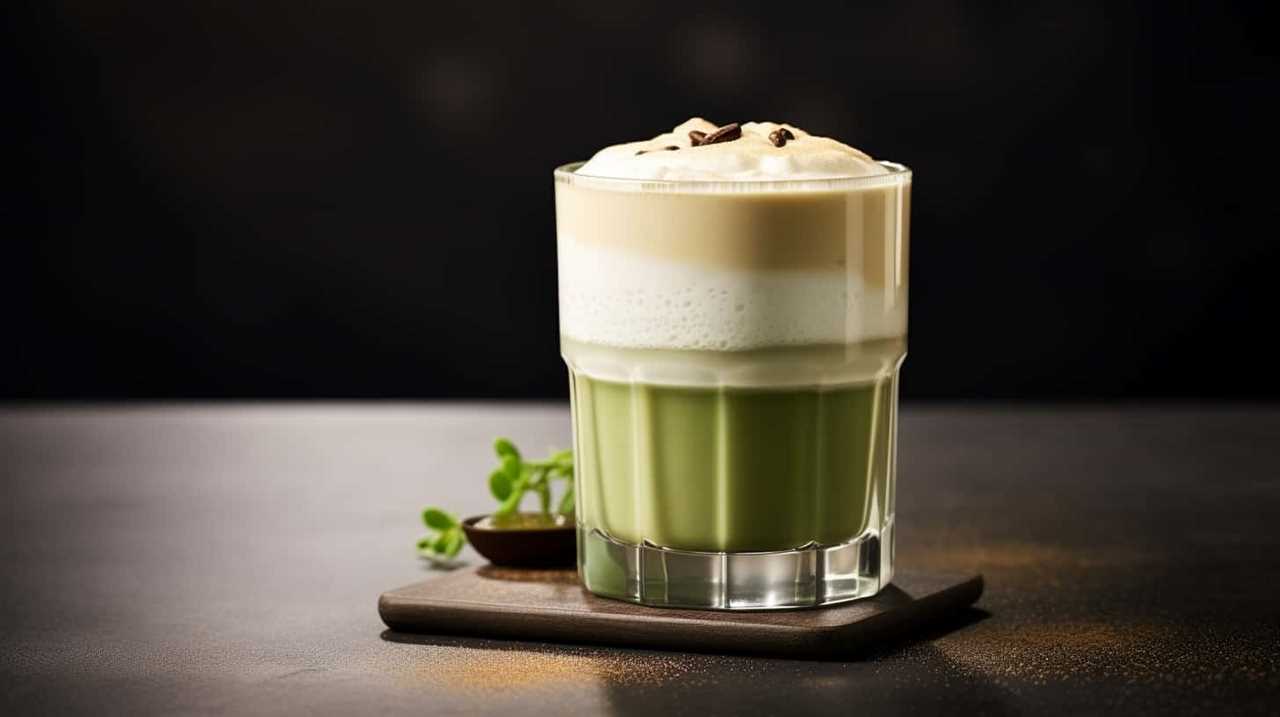
Here are four delightful combinations that will take your matcha experience to the next level:
- Lemon: The zingy and tangy taste of lemon complements matcha’s earthy notes, creating a harmonious balance of flavors.
- Orange: The natural sweetness of oranges enhances the smoothness of matcha, resulting in a creamy and citrusy delight.
- Grapefruit: The vibrant and slightly bitter taste of grapefruit adds complexity to matcha, awakening your taste buds with every sip.
- Yuzu: This unique Japanese citrus fruit brings a subtle and aromatic flavor to matcha, creating a truly exquisite and refreshing blend.
Pairing matcha with citrus flavors not only adds a burst of brightness to your cup but also elevates the overall taste profile, creating a truly memorable experience for those seeking mastery in the world of matcha.
Exploring Matcha Recipes to Mask the Earthy Taste
To mask the earthy taste of matcha, we explore various recipes that incorporate complementary flavors. Acquiring a taste for matcha can be challenging for some, as its distinct earthiness can be an acquired taste. However, by incorporating alternative ingredients and experimenting with different recipes, one can discover delightful ways to enjoy matcha without being overwhelmed by its earthy flavor.
Here are a few recipes that help mask the earthy taste of matcha:

| Recipe | Ingredients |
|---|---|
| Matcha Latte | Matcha powder, milk, sweetener of choice |
| Matcha Smoothie | Matcha powder, banana, spinach, almond milk |
| Matcha Ice Cream | Matcha powder, heavy cream, sugar, egg yolks |
These recipes provide a great starting point for those looking to enjoy matcha while minimizing its earthy taste. By incorporating ingredients like milk, sweeteners, fruits, and creamy bases, the unique flavor of matcha can be complemented and balanced, making it more palatable for those who are new to this vibrant green tea powder.
Matcha Variations for Different Palates
To cater to a range of tastes, we can explore different variations of matcha that offer unique flavor profiles. Matcha alternatives provide alternatives for those who find the earthy taste unpleasant. Here are some exciting options for flavor customization:
- Matcha Latte: This creamy and frothy beverage combines the richness of milk with the delicate bitterness of matcha. The sweetness of a touch of honey or agave syrup can further enhance the taste.
- Matcha Smoothie: Blending matcha with fruits like banana, mango, or berries creates a refreshing and nutritious drink. The natural sweetness of the fruits balances the bitter notes of matcha.
- Matcha Ice Cream: Indulge in a creamy dessert with a hint of matcha’s distinct flavor. The smooth texture and subtle bitterness make it a delightful treat.
- Matcha-infused Baked Goods: Incorporating matcha into cakes, cookies, or muffins adds a unique twist to traditional recipes, providing a pleasant surprise for your taste buds.
Exploring these matcha variations allows you to find a flavor profile that suits your palate.
Now, let’s move on to some tips for enjoying matcha without that dirt-like taste.

Tips for Enjoying Matcha Without the Dirt-like Taste
When it comes to enjoying matcha without the dirt-like taste, there are a few tricks that can make a world of difference.
Adding flavor-enhancing additives like honey or vanilla extract can help to mask the earthy notes and bring out the natural sweetness of the tea.
Additionally, paying attention to brewing temperature and time is crucial, as steeping matcha at too high a temperature or for too long can result in a bitter and unpleasant flavor.
With these tips in mind, you can elevate your matcha experience and enjoy its unique flavors without any dirt-like taste.
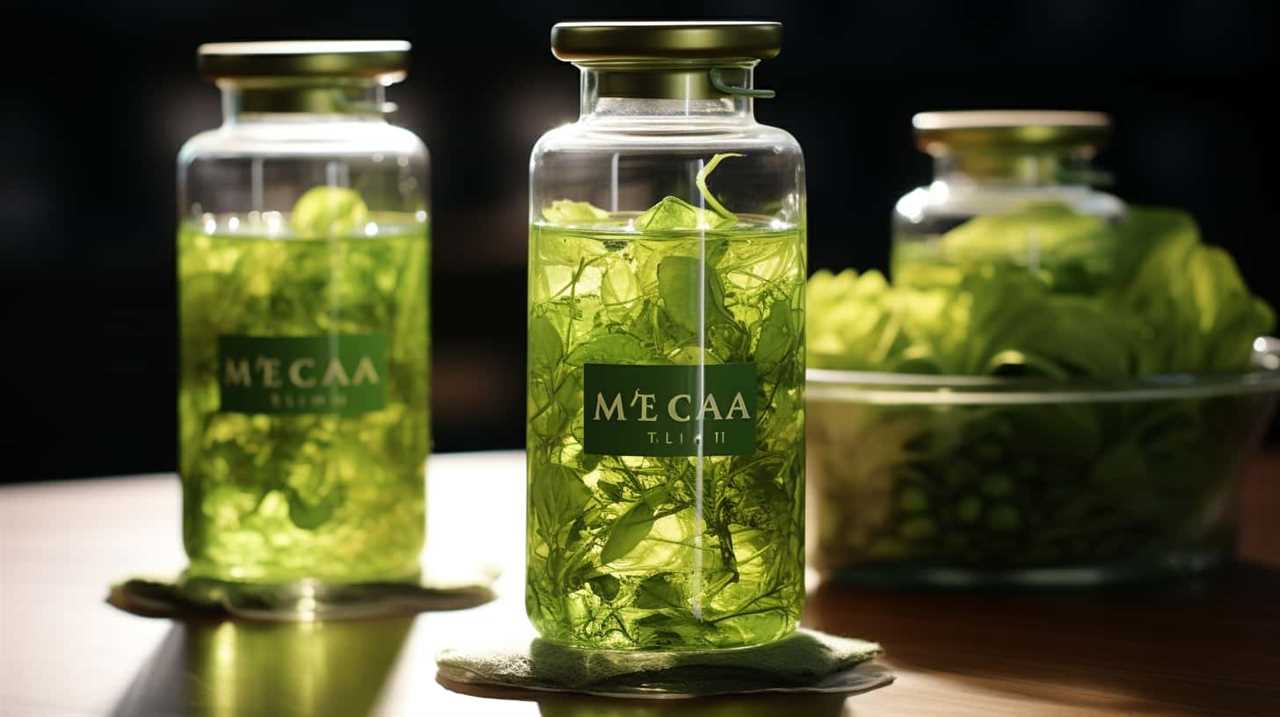
Flavor-Enhancing Additives
The addition of flavor-enhancing additives can enhance the taste of matcha, allowing us to enjoy it without the dirt-like flavor. Matcha is known for its unique taste, which some people find earthy and reminiscent of dirt. However, by incorporating certain flavor additives, you can transform the taste of matcha into a delightful experience.
Here are some tips to enhance your matcha without compromising its natural essence:
- Sweeteners: Adding a touch of honey, agave syrup, or stevia can balance out the earthiness and bring out the natural sweetness of matcha.
- Milk or cream: Mixing matcha with your favorite dairy or non-dairy milk can create a creamy and comforting texture, masking any unpleasant tastes.
- Citrus zest: Sprinkling a pinch of lemon or orange zest can add a refreshing citrusy note, elevating the overall flavor profile of matcha.
- Vanilla extract: A few drops of vanilla extract can lend a subtle sweetness and smoothness to matcha, making it more enjoyable.
Brewing Temperature and Time?
Our recommended brewing temperature and time for matcha is essential to ensuring a flavorful and enjoyable experience without the dirt-like taste. Proper brewing techniques allow for optimal flavor extraction, bringing out the natural sweetness and umami of the matcha while minimizing any bitter or earthy notes.
To achieve this, it’s crucial to use water that’s around 175°F (80°C). Water that’s too hot can scorch the delicate matcha leaves, resulting in a burnt and unpleasant taste.
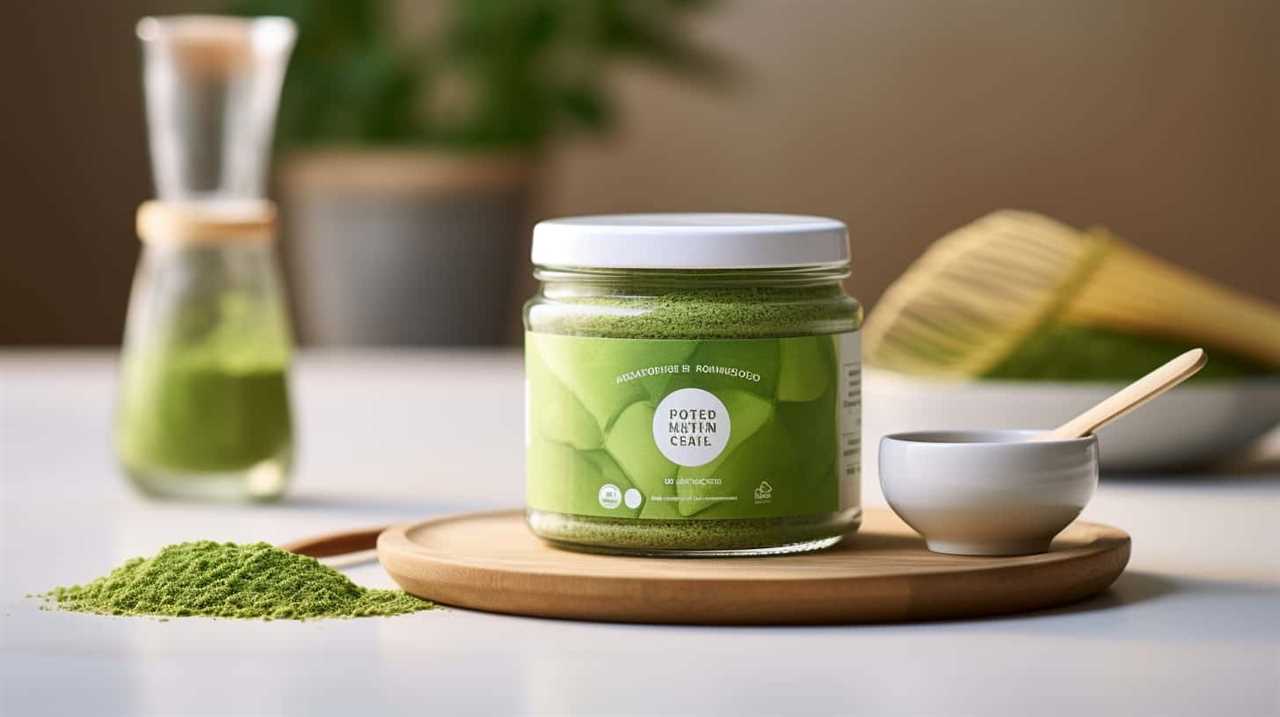
Additionally, the brewing time should be kept short, around 30 seconds to a minute, to prevent over-extraction and the release of any undesirable flavors.
Frequently Asked Questions
Can Matcha Be Made Without the Earthy Taste?
Alternative matcha flavors can be created to cater to different taste preferences. While some may enjoy the earthy taste, others may prefer a matcha with a milder flavor profile. It all comes down to personal preference.
What Factors Contribute to Matcha’s Dirt-Like Flavor?
Factors such as the cultivation process, growing conditions, and the quality of the leaves contribute to matcha’s unique earthy flavor. When compared to other earthy tasting foods, matcha stands out with its distinct and rich taste.
How Does the Processing Method Affect Matcha’s Taste?
Processing methods play a crucial role in shaping matcha’s flavor profiles. By carefully selecting and refining the tea leaves, the taste can range from earthy and vegetal to smooth and creamy. The artistry lies in finding the perfect balance.

Are There Different Variations of Matcha Available for Different Palates?
Yes, there are various matcha variations available to cater to different palates. Each variation offers a unique flavor profile, ranging from earthy and grassy to floral and sweet. It’s all about finding the perfect matcha that suits your taste preferences.
Are There Any Tips for Enjoying Matcha Without the Dirt-Like Taste?
When it comes to enhancing matcha flavor, there are a few tips we swear by. First, try adding a touch of honey or agave syrup to balance out any earthy notes. Alternatively, experiment with matcha flavoring alternatives like vanilla or almond extract.
Conclusion
In conclusion, while some may argue that matcha tastes like dirt, it’s important to delve deeper into the origins and flavor profile of this unique tea.
The earthy taste of matcha is a result of various factors, including the role of soil in its production.

However, by exploring different recipes and variations, it’s possible to discover a matcha that suits individual palates and enjoy this vibrant green tea without the dirt-like taste.
Justin is a seasoned author, coffee and tea enthusiast, and an essential member of the Cappuccino Oracle team. With a keen appreciation for the complexities of coffee, coffee alternatives, and tea, Justin has dedicated his professional career to exploring these realms and sharing his insights with readers worldwide.
Justin’s immersion in the world of coffee, coffee alternatives, and tea began at a young age, kindling a passion that extended beyond mere consumption. This love for these beverages led him to combine his talent for writing with his devotion to coffee and tea, bringing him to Cappuccino Oracle as a dedicated author.
Matcha
Unveiling The Mysteries Of Matcha: Insights On Its Origins, Production, And Quality

Have you ever been curious about the mysteries behind the rich and natural flavors of matcha? If so, get ready to join me on an adventure as we uncover the secrets of matcha, delving into its origins, production, and quality.
As a lover of all things tea, I have delved deep into the world of matcha, immersing myself in its rich history and intricate production process. From the shade-grown tea leaves to the meticulous grinding technique, every step is a labor of love that culminates in the velvety smooth powder we know as matcha.
Join me as we unravel the secrets behind this ancient Japanese tradition and discover why quality is key when indulging in this verdant elixir. We’ll explore the nuances of flavor, the importance of sourcing, and even delve into the fascinating world of other tea varieties.
So grab a cup, sit back, and let’s dive into the captivating world of matcha.
Key Takeaways
- Matcha tea is made from powdered green tea leaves and has a long and labor-intensive production process.
- Premium matcha is made from the first harvest in early spring, using the top 3 sprouts of the tea plant and ground tencha leaves.
- Cheaper matchas may skip some steps in the production process and are more suitable for matcha lattes.
- High-quality matcha is recommended for sparing consumption, as it has a smoother flavor and more health benefits compared to cheaper matchas.
What is matcha?
I’ve learned that matcha is a powdered green tea made from special tea leaves that are shaded before harvest, and it has a long and labor-intensive production process.
There are different types of matcha available, but the premium matcha is made from the first harvest in early spring, using only the top 3 sprouts of the tea plant. The leaves are then steamed, dried, and have their stems removed before being ground into a fine powder using a specialized mill made of granite.
It’s important to note that high-quality matcha is recommended for sparing consumption, as it has a complex production process that results in a smooth flavor. Matcha also offers various health benefits, such as being rich in antioxidants, boosting metabolism, and improving mental alertness.
Production process
The matcha production process involves shading the tea leaves before harvest and selecting the top three sprouts of the tea plant for premium matcha. Shading is a technique used to enhance the flavor and quality of the tea leaves. By covering the tea plants with shade, the leaves produce more chlorophyll and amino acids, resulting in a vibrant green color and a rich, umami taste.
After the shading period, only the top three sprouts of the tea plant are carefully handpicked for premium matcha. These selected leaves, known as tencha leaves, are then steamed, dried, and have their stems removed.
Finally, the tencha leaves are ground into a fine powder using a specialized granite mill. This process results in the smooth and concentrated matcha powder that we enjoy.
Quality and consumption
Let me tell you, indulging in high-quality matcha is like sipping a vibrant green elixir that awakens your taste buds and nourishes your body with its rich flavor and numerous health benefits. Matcha’s health benefits are truly remarkable. Packed with antioxidants, vitamins, and minerals, matcha is known to boost metabolism, enhance focus and concentration, and strengthen the immune system.
But not all matcha is created equal. Different grades of matcha exist, ranging from ceremonial grade to culinary grade. Ceremonial grade matcha is made from the highest quality tencha leaves and has a smooth, vibrant green color and a delicate, umami flavor. It is best enjoyed on its own, whisked with hot water.
On the other hand, culinary grade matcha is more affordable and is suitable for making matcha lattes, smoothies, and baked goods. Although it may have a slightly bitter taste and a duller color, it still provides health benefits.
So, whether you choose to indulge in high-quality ceremonial grade matcha or opt for the more affordable culinary grade, incorporating matcha into your routine is a delicious way to reap its health benefits.
Frequently Asked Questions
What are some popular ways to enjoy matcha besides drinking it as tea?
Besides drinking matcha as tea, some popular ways to enjoy it include indulging in matcha desserts like matcha ice cream, matcha cake, and matcha cookies. Additionally, matcha smoothies are a refreshing and healthy option.
Are there any specific health benefits associated with consuming matcha?
I’m no expert, but matcha is said to have potential health benefits. Some claim it can aid in weight loss due to its high antioxidant content and metabolism-boosting properties. However, more research is needed to confirm these claims.
How does the quality of matcha affect its flavor and overall experience?
The quality of matcha directly affects its flavor and overall experience. Higher quality matcha, made from carefully selected leaves and processed with precision, offers a smoother and more vibrant flavor, while lower quality matcha may have a less appealing taste and color.
Can matcha be used in cooking or baking?
"Where there’s matcha, there’s a way! Matcha can be used in a variety of cooking and baking recipes, adding a vibrant green color and a unique earthy flavor to dishes like matcha desserts."
Are there any specific tips or techniques for properly preparing matcha tea at home?
To properly prepare matcha tea at home, start by sifting the matcha powder to remove any clumps. Then, choose water at around 175°F to 180°F for the best flavor. Gradually add water to the matcha and whisk in a "W" or "M" motion until frothy. Enjoy!
Conclusion
In conclusion, matcha tea is not just a beverage, but a rich and fascinating tradition that has evolved over centuries.
From its origins in Japan to its intricate production process, matcha is a labor of love.
The quality of matcha is crucial, as the steps taken in its production directly impact its flavor and aroma.
Whether you’re a matcha connoisseur or a beginner, there is a matcha tea out there for you.
So, why not indulge in a cup of this vibrant green elixir and experience the magic of matcha for yourself? It’s a journey worth embarking on!
Arf, an author and an innovative enthusiast of coffee, coffee alternatives, and tea, plays a crucial role as a contributor to the esteemed Cappuccino Oracle platform. Renowned for his curiosity and passion for these captivating beverages, Arf has carved out a unique space for himself in the world of exploration and writing. He realized that coffee, coffee alternatives, and tea are not mere drinks to keep one awake, but universes of flavors and stories waiting to be explored.
Arf’s articles for Cappuccino Oracle blend meticulous research with personal experiences, providing readers with an in-depth understanding of various types of coffee, coffee alternatives, and tea, along with their unique characteristics, cultures, and histories. His honest reviews and engaging narratives guide readers on their own journeys, helping them discover their preferences and find their perfect brew.
Matcha
Unveiling The Truth Behind Starbucks’ Matcha: A Disappointing Blend

Being a lover of tea, I was eager to sample Starbucks’ matcha beverages, anticipating a flavorful and genuine taste. However, to my dismay, I found that it was a subpar mixture of inexpensive green tea powder and an excessive amount of sugar. This was a stark contrast to the customary matcha experience that I had grown accustomed to.
The use of low-quality matcha by Starbucks is driven by the need for mass production and a consistent taste across all locations. But in this pursuit, they have sacrificed the true essence of matcha. Authentic matcha production involves meticulous steps to ensure a high-quality and flavorful product, steps that Starbucks seems to skip.
The result is a matcha latte packed with 32 grams of sugar, equivalent to a can of soda, and a whopping 240 calories. It’s time to unveil the truth behind Starbucks’ matcha and explore better options for a truly satisfying tea experience.
Key Takeaways
- Starbucks uses a cheap green tea powder for their matcha drinks, which may not even be considered matcha.
- The cheap matcha powder is mixed with a lot of sugar, negating the health benefits and undermining the quality of the tea.
- Starbucks’ matcha latte contains a high amount of sugar, similar to a can of soda, and has a significant number of calories.
- To have a better matcha experience, it is recommended to explore premium, first harvest matcha made by talented farmers in Japan and to try different matcha options to find preferred taste.
What is Starbucks Matcha?
Starbucks Matcha is a cheap green tea powder mixed with a high amount of sugar, which not only undermines the health benefits of matcha but also fails to deliver the natural, great-tasting flavor of authentic matcha tea.
The ingredients used in Starbucks matcha include low-quality green tea powder that is likely produced on a large scale. Unlike traditional matcha production methods, Starbucks skips certain steps to save time and money. These steps, such as shading the tea plants to reduce bitterness and selecting the top leaves for their flavor and nutrients, are crucial in creating high-quality matcha.
Instead, Starbucks opts for a blend of cheap green tea powder mixed with sugar, resulting in a dull and bitter flavor. This disappointing blend of ingredients does not live up to the standards of true matcha tea.
Quality vs. Cheap Matcha
Indulging in high-quality matcha is like savoring a delicate melody that dances on your taste buds, while settling for cheap matcha is akin to a discordant symphony that leaves a bitter aftertaste. When it comes to matcha, quality matters. Traditional matcha production is an art that requires time, patience, and attention to detail. The importance of shading the tea plants, selecting the top leaves, and using a stone mill to grind the leaves into a fine powder cannot be overstated. These steps not only enhance the flavor but also preserve the health benefits of matcha. High-quality matcha is rich in antioxidants, boosts metabolism, and promotes a sense of calm. On the other hand, cheap matcha often lacks these qualities as it skips crucial steps and is mixed with sugar and other additives. Don’t settle for a subpar matcha experience; choose high-quality matcha for its exceptional taste and health benefits.
| Traditional Matcha Production |
|---|
| Shading the tea plants |
| Selecting the top leaves |
| Grinding with a stone mill |
The importance of traditional matcha production cannot be overstated. These steps not only enhance the flavor but also preserve the health benefits of matcha. High-quality matcha is rich in antioxidants, boosts metabolism, and promotes a sense of calm. On the other hand, cheap matcha often lacks these qualities as it skips crucial steps and is mixed with sugar and other additives. Don’t settle for a subpar matcha experience; choose high-quality matcha for its exceptional taste and health benefits.
Recommendations for Better Matcha
Exploring different matcha options can lead to a better matcha experience. When it comes to matcha, not all options are created equal. While Starbucks may offer a convenient matcha latte, there are alternative options that provide a more authentic and higher quality experience.
Premium matcha, specifically first harvest matcha, is made by talented farmers in Japan and can be enjoyed plain, without the need for excessive sugar or additives. By choosing premium matcha, you can reap the full benefits that matcha has to offer, such as its high antioxidant content and potential health benefits.
Additionally, exploring different types of matcha, such as Japanese black tea, can expand your taste palate and introduce you to new and exciting flavors. So, why settle for a disappointing blend when there are better matcha options out there waiting to be explored?
Frequently Asked Questions
How is Starbucks matcha different from traditional matcha?
Starbucks matcha differs from traditional matcha in terms of quality and taste. One interesting statistic is that Starbucks’ matcha latte contains 32 grams of sugar, similar to a can of soda, which undermines the health benefits of matcha.
What are the health benefits of matcha and how do they differ between Starbucks matcha and premium matcha?
The health benefits of matcha include high levels of antioxidants, increased energy, and improved focus. However, Starbucks matcha quality is compromised due to the use of cheap powder mixed with sugar, negating these benefits.
Can you customize the sweetness level of Starbucks matcha drinks?
Yes, you can customize the sweetness level of Starbucks matcha drinks. They offer popular matcha drink variations like matcha latte and matcha frappuccino, allowing customers to choose the amount of sweetener they prefer.
Are there any alternative options for matcha drinks at Starbucks?
Yes, there are alternative options for matcha drinks at Starbucks. However, it’s important to note that the taste may not be comparable to traditional matcha. Exploring different matcha options and Japanese black tea can provide a better experience.
What are the steps involved in producing high-quality matcha and how does Starbucks’ matcha production differ?
Starbucks’ matcha production process differs from traditional matcha production in Japan. High-quality matcha involves shading the tea plants, selecting the top leaves, steaming, drying, and grinding them. However, Starbucks skips these steps, resulting in a lower quality and less authentic matcha experience.
Conclusion
In conclusion, after delving into the truth behind Starbucks’ matcha, it’s clear that their blend falls short of expectations. The use of cheap green tea powder mixed with excessive sugar dilutes any potential health benefits and fails to deliver an authentic matcha experience.
To truly enjoy the rich and flavorful taste of matcha, it’s recommended to explore premium, first harvest options crafted by skilled Japanese farmers. Don’t settle for subpar matcha; treat yourself to a tea experience that’ll leave your taste buds dancing with delight.
Arf, an author and an innovative enthusiast of coffee, coffee alternatives, and tea, plays a crucial role as a contributor to the esteemed Cappuccino Oracle platform. Renowned for his curiosity and passion for these captivating beverages, Arf has carved out a unique space for himself in the world of exploration and writing. He realized that coffee, coffee alternatives, and tea are not mere drinks to keep one awake, but universes of flavors and stories waiting to be explored.
Arf’s articles for Cappuccino Oracle blend meticulous research with personal experiences, providing readers with an in-depth understanding of various types of coffee, coffee alternatives, and tea, along with their unique characteristics, cultures, and histories. His honest reviews and engaging narratives guide readers on their own journeys, helping them discover their preferences and find their perfect brew.
Matcha
The Ultimate Guide To Using Chashaku: Your Matcha Essential

Being a lover of matcha, I am aware that the crucial factor in achieving the perfect matcha bowl is the equipment we utilize. When it comes to preparing matcha, there is one tool that is particularly essential: the chashaku.
This bamboo spoon, with its elegant design and precise measurements, is the secret weapon of matcha lovers worldwide. In this ultimate guide, I will take you on a journey through the history and evolution of the chashaku, and show you how to use it like a pro.
From its origins as a metal or ivory scoop to its modern-day incarnation in bamboo, the chashaku has come a long way. With its 48° bend and 18mm length, it effortlessly scoops the perfect amount of matcha from its container.
So grab your chashaku and get ready to elevate your matcha game to new heights. Let’s dive in and discover the wonders of this matcha essential.
Key Takeaways
- Chashaku is a bamboo spoon used to scoop matcha powder in the Japanese tea ceremony and by matcha lovers worldwide.
- Chashaku is one of the three important tea utensils used in the tea ceremony and is about 18mm in length with a 48° bend at the end for scooping.
- Chashaku is made of bamboo to avoid negative reactions with matcha powder and is a great measurement tool for matcha powder.
- Two scoops of chashaku is the standard amount for a bowl of matcha tea, and it is easy to maneuver in matcha tins or natsume due to its small size.
What is Chashaku?
Chashaku is a bamboo spoon used to scoop matcha powder, and it’s one of the three important tea utensils used in the Japanese tea ceremony.
Made from a single piece of bamboo, this elegant tool has a long history dating back to the Muromachi period in Japan. Originally crafted from metal or ivory, chashaku evolved to be made of bamboo due to its natural properties and to avoid any negative reactions with matcha powder.
The design of chashaku is both functional and beautiful, with a length of about 18mm and a 48° bend at the end for easy scooping. There are different styles of chashaku scoops, each with its own unique shape and characteristics. The back of the chashaku has a rough texture, while the face is smooth and sleek.
Whether you’re a matcha lover or a tea ceremony enthusiast, using a chashaku adds a touch of authenticity and tradition to your matcha preparation.
History and Evolution
During the Muromachi period in Japan, the chashaku spoon evolved from being made of metal or ivory to its current bamboo form, which is about 18mm in length and has a 48° bend at the end for easier scooping. The history and evolution of the chashaku is a testament to its significance in Japanese tea ceremonies and its cultural importance in matcha preparation.
| The significance of chashaku in Japanese tea ceremonies | The cultural importance of chashaku in matcha preparation |
|---|---|
| Chashaku is one of the three important tea utensils used in the tea ceremony. | Chashaku is a great measurement tool for matcha powder. |
| Chashaku originated in Japan during the Muromachi period. | Chashaku’s small size allows for easy maneuvering in matcha tins or natsume. |
| Originally made of metal or ivory, chashaku evolved to be made of bamboo. | Chashaku is made from a single piece of bamboo and shaped with a bend for the scoop. |
| Chashaku is made of bamboo to avoid negative reactions with matcha powder. | The back of chashaku has a rough texture, while the face is smooth and sleek. |
The chashaku’s role in Japanese tea ceremonies cannot be understated. It is one of the three essential utensils used in the tea ceremony, alongside the chawan (tea bowl) and chasen (tea whisk). The chashaku’s small size and precise measurement make it the perfect tool for scooping matcha powder. Its evolution from metal or ivory to bamboo shows the cultural importance placed on this utensil. The chashaku’s design, with its gentle bend and smooth face, allows for easy and graceful scooping of matcha. Using the chashaku is not only practical but also a way to honor the centuries-old tradition of matcha preparation.
How to Use Chashaku
To use the chashaku, I simply hold it like a pencil and dip the scoop into the matcha container. Then, I carefully lift the chashaku scoop out and place it over the matcha bowl to dump the powder.
It’s a simple and elegant technique that ensures the perfect amount of matcha every time.
But did you know that there are alternative ways to use the chashaku? Some matcha lovers prefer to use a teaspoon or a regular spoon to scoop their matcha powder. While these alternatives may work in a pinch, they don’t offer the same precision and authenticity as the chashaku.
The chashaku’s unique design and size make it the ideal tool for measuring matcha powder. Plus, using the chashaku adds a traditional touch to the matcha preparation process, enhancing the overall experience.
So why settle for anything less? Embrace the chashaku and elevate your matcha game to the next level.
Frequently Asked Questions
What are the different types of materials used to make chashaku besides bamboo?
There’s something truly magical about the chashaku, the bamboo spoon that gracefully scoops matcha powder. While bamboo is the traditional material, chashaku can also be made from metal or ivory, although these alternatives are less common.
Can chashaku be used to scoop other powders besides matcha?
Yes, chashaku can be used to scoop other powders besides matcha. However, it is primarily designed for scooping matcha powder and is most commonly used in Japanese tea ceremonies. To properly clean and care for a chashaku, it is recommended to wipe it with a dry towel or tissue to avoid water damage. The chashaku is a versatile tool with different uses in the tea ceremony, making it an essential item for matcha lovers.
How long does a chashaku typically last before it needs to be replaced?
A chashaku typically lasts for a long time, but the lifespan can vary depending on the material. Bamboo chashaku is the most common and durable option, while metal or ivory may wear down over time. Proper care involves cleaning with a dry towel or tissue to avoid water damage.
Can chashaku be used with different types of matcha bowls or is it specific to a certain style?
Absolutely! Chashaku can be used with various types of matcha bowls, adapting to different styles. Its small size and unique design make it perfect for scooping matcha powder and adding a touch of elegance to your matcha preparation.
Are there any alternative utensils that can be used in place of chashaku for scooping matcha powder?
Yes, there are alternative utensils for scooping matcha powder, such as a teaspoon or a small spoon. However, using a chashaku has its benefits. Its unique design allows for precise measurements and easy maneuvering in matcha tins.
Conclusion
In conclusion, using chashaku isn’t just a practical way to measure and scoop matcha powder, but it’s also an essential tool for embracing the art and tradition of the Japanese tea ceremony.
While some may argue that using a regular spoon can achieve the same result, chashaku offers a unique experience that connects us to centuries of tea culture. Imagine holding the slender bamboo spoon, feeling the weight of tradition in your hand, and delicately scooping the vibrant green matcha powder.
It’s a sensory journey that brings us closer to the beauty and mindfulness of matcha preparation. So, embrace the chashaku, and let it elevate your matcha experience to new heights.
Arf, an author and an innovative enthusiast of coffee, coffee alternatives, and tea, plays a crucial role as a contributor to the esteemed Cappuccino Oracle platform. Renowned for his curiosity and passion for these captivating beverages, Arf has carved out a unique space for himself in the world of exploration and writing. He realized that coffee, coffee alternatives, and tea are not mere drinks to keep one awake, but universes of flavors and stories waiting to be explored.
Arf’s articles for Cappuccino Oracle blend meticulous research with personal experiences, providing readers with an in-depth understanding of various types of coffee, coffee alternatives, and tea, along with their unique characteristics, cultures, and histories. His honest reviews and engaging narratives guide readers on their own journeys, helping them discover their preferences and find their perfect brew.
-

 Americano2 weeks ago
Americano2 weeks agoHow to Make Korean Iced Americano
-

 Americano4 weeks ago
Americano4 weeks agoHow to Make Americano With Moka Pot
-

 Americano4 weeks ago
Americano4 weeks agoHow to Make Iced Americano With Instant Coffee
-

 Americano4 weeks ago
Americano4 weeks agoHow to Make Americano With Bialetti
-

 Americano4 weeks ago
Americano4 weeks agoHow to Make Dutch Bros Americano
-

 Americano7 days ago
Americano7 days agoHow to Make an Iced Americano With Nespresso
-

 Americano2 weeks ago
Americano2 weeks agoHow Many Shots of Espresso for 16 Oz Americano
-

 Americano4 weeks ago
Americano4 weeks agoHow to Make a Hazelnut Americano

















